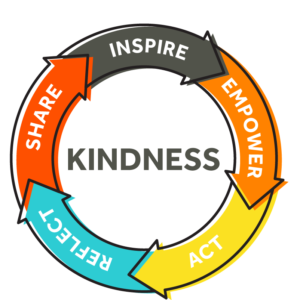
World Kindness Day 11/13
Kindness isn’t a natural instinct. In the continuum of nature vs. nurture, it’s well on the side of nurture. Kids aren’t born knowing the part community and friendship play in their lives. They learn this from family, friends, schoolmates, and life in general.
That means, among the topics that must be covered in school, kindness may be the most important.
What is kindness?
Kindness is exactly what it sounds like — being friendly, generous, and considerate to others whether or not you think they deserve it. It’s not a payoff to someone who treated you well; it’s an attitude that seeps into every action in a person’s life.
It’s interesting that some variation of “kindness” is included in most non-academic measures of what students should learn in school, including Habits of Mind, a Growth Mindset, and Mindfulness (click links for further discussion).
Why is it important?
Kids learn by example. It’s unfortunate to note that some don’t see kindness in their homes. What they experience instead, they may think is the norm until you — their trusted teacher — shows them otherwise. This isn’t as easy as it sounds. You must always have your antenna up, noticing when you need to intervene to tweak actions. This could be gossip, mean words, (cyber)bullying, or even speech that is accepted by most because “doesn’t everyone think this way”. Your job isn’t to stop whatever is going on but redirect and explain so students learn why what they’re doing isn’t kind.
Why teach this in school, you ask? The quick answer is that students spend half their waking hours in or around school. It has a huge impact on how they view their world and their lives. But it’s more than that. Establishing a kind school culture resonates in all parts of a child’s life:
“Positive school climate has been empirically linked to a number of favorable outcomes, notably, the promotion of feelings of safety; establishing and maintaining healthy relationships, reductions in misbehavior, increases in students’ academic, emotional, and behavioral success at school; teaching that is engaging and promotes learning, and improvements in the overall quality of schools.” (Measuring Kindness in School, John Tyler Binfet, 2015)
In short, if students see kindness modeled in school, they are more likely to duplicate that in their own lives and activities.
Websites that teach Kindness
There are surprisingly a lot of them. Four I’ve talked about in the past are:
- Class Dojo
- Empatico (see my review)
- Hero K12
- Sown to Grow (see my review)
All of these teach students to recognize kindness, participate in it, and encourage it in others. These websites (and others) help to create habits that stay with students well beyond the schoolhouse walls.
Building personal empathy requires creating a culture of kindness in your classroom, your school, and within each student. The following acts of kindness can be completed anywhere, anytime, with a small or large commitment, and no financial investment. World Kindness Day is coming up on November 13, 2018. Make that the day all students push to complete at least three of these activities and share their success with classmates.
Note: I curated this list from online sites like Canada’s Human Kindness Project, Megan’s Coffee Cups, and Crayons, as well as suggestions from fellow teachers.
Elementary School Students
- Do a chore without being reminded.
- Do your homework without being reminded.
- Go to bed without being reminded.
- Help mom or dad carry in the groceries.
- Hold the door open for someone.
- Pick up a piece of garbage and throw it away.
- Practice good manners even when others don’t.
- Say “Thank you” to a crossing guard.
- Sit next to someone at lunch who you don’t usually talk to.
- Smile at three people.
- Start a conversation with a new student or with a classmate who seems lonely etc.
- Wave hello to the school principal.
Middle School Students
- Bring coffee to your mom.
- Call a relative you don’t often talk to.
- Carry your friend’s books or bag to class.
- Draw a picture and give it to someone you don’t know.
- Have a lemonade stand on a hot day with free drinks.
- Help a teacher after school.
- Help a younger child with their schoolwork.
- Learn to say “Hello” and “Thank you” in a new language (that someone speaks at your school).
- Leave fresh water out for neighborhood dogs.
- Let your sister pick what you watch on TV.
- Offer to help your teacher during lunch or after school.
- Shovel a neighbor’s drive when it snows.
- Write a gratitude card and give it to someone who works at the school.
High School Students
- Be on time for school.
- Create a show about kindness and present it to elementary schools (e.g. a puppet show, music performance, play).
- Do a happy dance for someone.
- Do a random act of kindness for someone.
- Do something you don’t want to just because it’s the right thing to do.
- Go to the library and thank the librarian if s/he helps you with something.
- Include someone who looks alone in a group.
- Mow a neighbor’s lawn or bring their mail in (or move their trashcans).
- Pay it forward — whatever way works best for you.
- Play your younger sibling’s favorite game with them.
- Run a 5K for a good cause.
- Set up a Little Free Library at your school or neighborhood.
- Sit with someone at lunch that you usually don’t speak with.
- Stick up for a friend when no one else will.
- Take a flower to the office staff.
- Walk or bike to school and help the environment.
- Write a thank you note for a mentor or someone who has influenced your life in a positive way.
Service Projects
There are a lot of service projects that focus on helping others. Often this includes donations of foodstuff or money, collections of clothing and holiday gifts, or creating posters that educate on the importance of treating the world well. The next level of service learning is a full-blown, time-intensive service project that requires an ongoing commitment from students (not parents) with a payoff that is tremendous. Spending time with those who benefit from kindness is probably the biggest lesson students can learn as they grow up.
One of my favorite easy-to-do and non-threatening ones is for students to teach others what they have learned. That can be sports, tutoring, or in this case, how to use technology. I write about setting up a service learning program where students teacher elders at a senior center how to do the common tech tasks everyone else takes for granted (digital photos, email, and online chatting to name a few). Everywhere this has been tried, it’s been a staggering success. No surprise, students learn their subject better when they teach it and the elders learn skills that can be used in every aspect of their lives.
***
These acts of kindness can be curated in the school newsletter, applauded at a school assembly, and/or discussed in the classroom. You might require a certain number be completed each year, each grading period, or not keep track of them. Do whatever works for your group. The only “must” is that kindness happens in the bright light of day, under a spotlight, where others see it.
—Kindness paradigm image detail: The Random Acts of Kindness Foundation’s “Kindness in the Classroom” curriculum follows the framework that every lesson and activity offers inspiration and empowerment followed by an opportunity to act, reflect and share in the classroom and/or school.
–Comments are closed but feel free to contact me via Twitter (@askatechteacher).
Jacqui Murray has been teaching K-18 technology for 30 years. She is the editor/author of over a hundred tech ed resources including a K-12 technology curriculum, K-8 keyboard curriculum, K-8 Digital Citizenship curriculum. She is an adjunct professor in tech ed, Master Teacher, webmaster for four blogs, an Amazon Vine Voice, CSTA presentation reviewer, freelance journalist on tech ed topics, contributor to NEA Today, and author of the tech thrillers, To Hunt a Sub and Twenty-four Days. You can find her resources at Structured Learning.



































